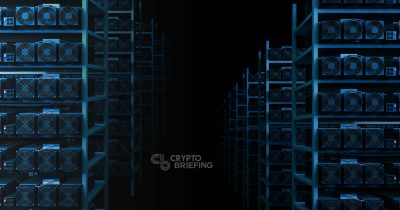Bitcoin's Upcoming Halving Exposes Long-Term Security Issues
Fees will need to increase for the network to remain secure.

Share this article
Bitcoin’s network security largely depends on block rewards, not transaction fees. Will fees alone be enough to sustain the network as halvings continue to erode miner revenues?
What does network security mean?
The decentralization and immutability of a blockchain network lies in its resistance to the double-spend problem. For proof-of-work, this means its resistance to the hashrate-related “51 percent attack.”
Controlling more than half of the network hashrate, and thus more than half of block production, allows an entity to rearrange the chain however it sees fit. Such an attack could ‘erase’ legitimate transactions. By creating seemingly valid transactions and then reversing them an attacker could profit from say, a trade on an exchange, without spending any of their Bitcoin.
The total network hashrate is the amount of computing power dedicated to securing the blockchain and is often considered a measure of network security. Its highs are frequently interpreted as bullish indicators for Bitcoin – implying a higher resistance to 51 percent attacks.
Bitcoin hashrate back at all time highs!!
Miners are clearly not being deterred by this week's price action. 🚀🌛 pic.twitter.com/87R9so5SaN
— Mati Greenspan (@MatiGreenspan) September 27, 2019
And while this interpretation is generally true, it is an oversimplification.
Network hashrate, the sum of all the mining devices operating at any given time, should not be analyzed in a vacuum. The cost and hashing efficiency of these devices can vary by many orders of magnitude which directly impacts the cost of conducting a 51 percent attack.
In Bitcoin’s early days, mining could be done on home computers. Today, extremely efficient application specific integrated circuit chips are responsible for virtually all of the network’s hashrate. The difference is astounding: a top-of-the-line CPU in 2013 could mine at a speed of 64 Megahashes per second while modern ASICs mine at 53 Terahashes per second — a 828,124-fold difference.
Large increases in network hashrate generally happen for two reasons: increases in BTC’s price or advancements in ASIC technology. In both circumstances, it keeps rising until it reaches a new economic equilibrium defined by the profitability of the most efficient machine. Each additional device decreases the slice of the pie for everyone else, and, at some point, miners begin turning off the machines that cost more in electricity than they gain in block rewards and collected fees.
Both growth triggers were observed in 2019. The Bitcoin price increased by approximately three times while the new Bitmain S17 family of ASICs was released in April 2019. Therefore, the hashrate kept increasing in the second half of the year despite the falling price.
The cost of a 51 percent attack
A rough estimate of the price of conducting a network attack can be obtained by calculating how many top-of-the-line devices are needed to recreate the existing hashrate. This approach introduces several simplifications. It assumes that the attacker does not already control part of the hashrate and discounts production, set up, and electricity costs for operating these new machines. It also assumes that the primary ASIC manufacturers, Bitmain and Canaan, are willing to sell these specialized devices at that volume (rather than mining for themselves).
The industry-leading Bitmain S17 Pro produces 53 TH/s and costs $2,500 per unit. The current hashrate is 90 Exahashes per second. Approximately 1.7 million devices are required at a cost of $4.2 billion.
Surprisingly, this wasn’t much higher than in Feb. 2019 when the Bitmain S15 was still the most powerful ASIC. About $2.6 billion was required to cover 44 Exahashes of network hashrate with the S15’s 28 TH/s performance and $1,700 price. That amounts to only a 58 percent increase in attack cost versus a 104 percent increase in hashrate. As a result, increases in hashrate can be misleading in terms of evaluating Bitcoin’s security.
Will the halving affect security?
Ultimately, as the Bitcoin block reward continues to halve more and more of the network’s security will depend on fees. Sometime in 2140 block rewards will stop entirely, meaning the network will need to run entirely on transaction fees unless fundamental changes are made to Bitcoin’s code (which seems unlikely).
The daily revenue from fees currently amounts to about $350,000, or just 2.2 percent of the daily block reward revenue of $15.8 million. As the block reward halving looms, fees will need to increase by 22 times to cover the incoming shortfall in revenue. Otherwise, the hashrate will drop and the security of the network will decrease.
This isn’t just speculation. Litecoin had its halving in August of this year and the network’s hashrate dropped by nearly 30%. The cost of a 51% attack after the halving is likely to plummet to approximately $2.1 billion if the BTC price remains similar.
Meanwhile, if fees were to increase the network may stunt its long-term user growth. In December 2017 daily fee revenues peaked at $3 million. However, the network had to first experience crippling congestion where, at its peak, fees exceeded $50 to process a transaction in a reasonable amount of time.
That said, it is also possible to spend too much and too little on network security — and these figures are almost entirely subjective.
Back in late 2017 the Bitcoin hashrate amounted to 10 Exahashes per second, or about 740,000 state-of-the-art Bitmain S9s worth $1.5 billion. If Bitcoin were to halve today it would still be more secure than if it halved when the Bitcoin price peaked at just under $20,000.
Nevertheless, Bitcoin adoption still has a long way to go. If the network was to rely entirely on fees the cost of a 51 percent attack would be less than $85 million, or about 0.06 percent of its current market capitalization. How this trend will unfold as the block reward continues to decrease is yet to be seen.
